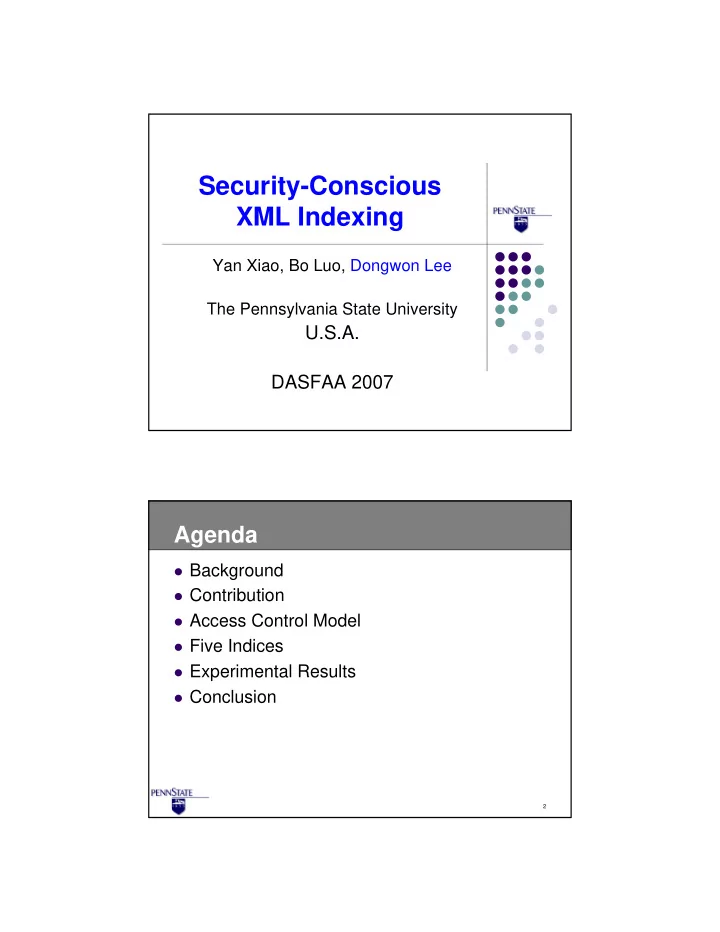

Security-Conscious XML Indexing Yan Xiao, Bo Luo, Dongwon Lee The Pennsylvania State University U.S.A. DASFAA 2007 Agenda � Background � Contribution � Access Control Model � Five Indices � Experimental Results � Conclusion 2
Motivation � Secure exchange and sharing of XML data needs XML access controls � Secure XML query processing = locating XML nodes that: � Satisfy query constraints � Do not violate security policies � In this paper, we propose various indexing schemes that speed up this secure XML query processing 3 Background Two-tier Coarse Indexing Scheme for MLS Database Systems (Sushil Jajodia. DB Security, 1998) � Two-tier Indexing Scheme : � Improve query response time � Reduce the storage required for indexing � Three Index Structures: � Single-level Index � Global Multilevel Index � Two-tier Coarse Index 4
Background Indexing and Querying XML Data for Regular Path Expressions (Quanzhong Li, Bongki Moon, 27 th VLDB Conference, 2001) � Numbering Scheme � XISS - a system for indexing and storing XML data based on a numbering scheme. � Three major index structures (element index, attribute index, structure index) � Path-join algorithms: � Decompose regular path expressions � Path-join algorithms 5 Contribution � Add Access Control Function to XISS � Five Index Structures � Global Index (GI) � Single-level Index (SLI) � Minimum-Security Index (MSI) � Skip-Record Index (SRI) � Skip-Forward Index (SFI) � Analysis and Experimental Results 6
Access Control Model � Multilevel Security Model � Total order L security levels from 1 (lowest) to L (highest) � � Each XML element and attribute will be specified a security level. � Assign security levels in DTD/Schema Assign security levels in XML documents Eg: <a name=‘Lee’ s_name=1 bod=‘3/3/70’ s_bod=5… /> � SL in XML documents can overwrite that in XML schema � If no security is assigned, security level is 1 � XML query with specified level is written as � {L}:Q (e.g., {3}://a//b) 7 Access Control Model � User will be assigned a security level. � Only XML data whose security requirement is lower than or equal to user’s authorization can be returned. <?xml version="1.0" encoding="utf-8"?> <books> User’s assigned security level >=3, can access title, <book> price, unit. <author> <firstname>Yan</firstname> User’s assigned security level < 2, can not access title, <lastname>Xiao</lastname> price, unit. </author> <title s_title=’’2’’>XML Indexing</title> <price s_price=’’3’’ unit = "USD" s_unit=’’3’’>50</price> </book> User’s assigned security level = 2, can access title. </books> cannot access price, unit. 8
XISS Index Structure B+ Tree on element names name price 2 5 10 … 34 -1 DOC ID list Element list price <order,size> price depth, parentID, … … price 9 Global Index (GI) Query: {3}://price price nid Query Step: B+ tree 1. Find a document list for the 2 3 6 10 element; Doc id list 2. Security check for the element. price <order, size> Depth price Parent ID Security price Disadvantages: Security check at element level Not efficient for single-level queries 10
Single-level Index (SLI) price nid B+ tree … … … Doc … … 2 3 15 id list price (1) price (5) price (L) … … … price (1) price (5) price (L) price (1) price (5) price (L) … … … Security 1 Security 5 Security L • Single –level Index: Separate Index at each security level. • Disadvantages: Use more storage room Not efficient for range queries 11 Minimum Security Index (MSI) nid1’s Minimum Security 12
Minimum Security Index (MSI) price nid Query: • If user’s security < 4, Security Index 4 5 no documents need to be checked. • If user’s security = 4, Doc ID list 6 3 check document 6 only. Security 4 Security 5 • If user’s security >= 5 check document 6 and 3. price (sec=4) price (sec=6) price (sec=4) price (sec=6) Sorted by price (sec=4) price (sec=5) Order Security check at document level Disadvantages: not effective if the element has big confidentiality difference within a document. 13 Skip-Record Index (SRI) ... <price s_price =’’4’’> (1) (skip_records = 2) ... <price s_price =’’4’’> (2) (skip_records = 1) ... <price s_price =’’5’’> (3) (skip_records = 0) ... <price s_price =’’3’’> (4) (skip_records = 0) ... <price s_price =’’2’’> (5) (skip_records = -1) ... Stop! <price s_price =’’7’’> (6) (skip_records = 0) ... <price s_price =’’6’’> (7) (skip_records = -1) ... <price s_price =’’8’’> (8) (skip_records = -1) ... <price s_price =’’9’’> (8) (skip_records = -1) Query: {3}://price 14
Skip-Forward Index (SFI) <root> root <a s_a=3><b s_b=4/> </a> // a1, b1 <a s_a=3><b s_b=4/> </a> // a2, b2 a a a a <a s_a=3><b s_b=4/> </a> // a3, b3 3,2 3,1 3,0 1,-1 <a s_a=1><b s_b=2/> </a> // a4, b4 b b b b </root> 4,2 4,1 4,0 2,-1 security level skip-record � Query: {3}://a/b � Get all “a” nodes with satisfactory constraints � Get all “b” nodes with satisfactory constraints � Sort-merge two lists and return all final “b” 15 Skip-Forward Index (SFI) � {3}://a/b root � a list: a1(3,2), a2(3,1), a3(3,0), a4(1,-1) a1 a2 a3 a4 3,2 3,1 3,0 1,-1 � b list: b1(4,2), b2(4,1), b3(4,0), b4(2,-1) b1 b2 b3 b4 � a1-b1 pair 4,2 4,1 4,0 2,-1 � Sort-merge: satisfy “/” relationship � Security check: b1’s SL > 4: X Monotonic security model: � a1-b2 & a1-b3 pairs: skipped ancestors’ SL <= � a2-b4 pair descendents’ SL � a3-b4 pair … 16
Experiment and Results 17 Experiment and Results 18
Conclusion � Proposed five variations of indices that support security checks for multi-level based XML access controls � SRI or SFI was able to improve other variations up to 130% at best � Future work � Extend to other state-of-the-art XML indexing schemes � Extend to DAC or RBAC models 19
Recommend
More recommend